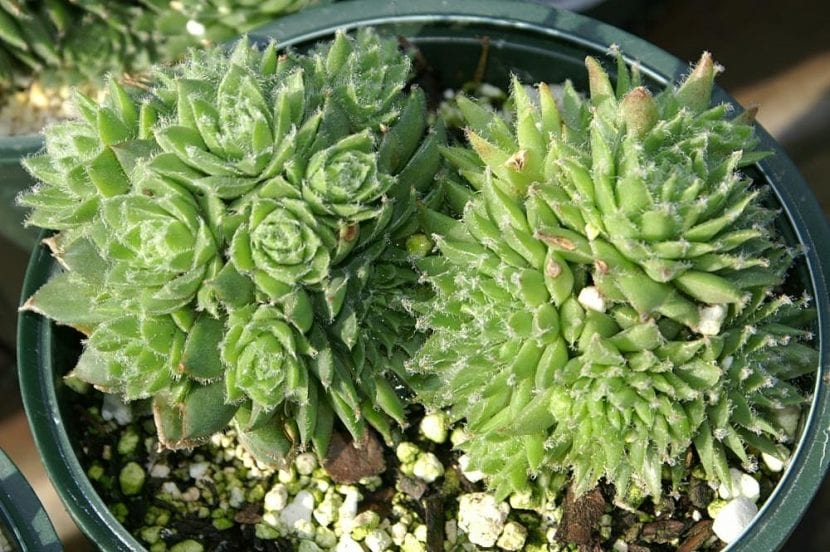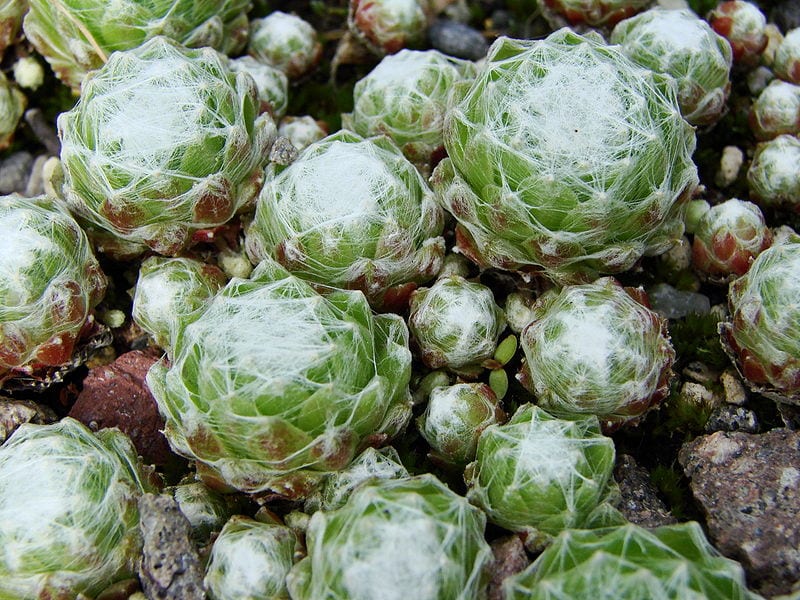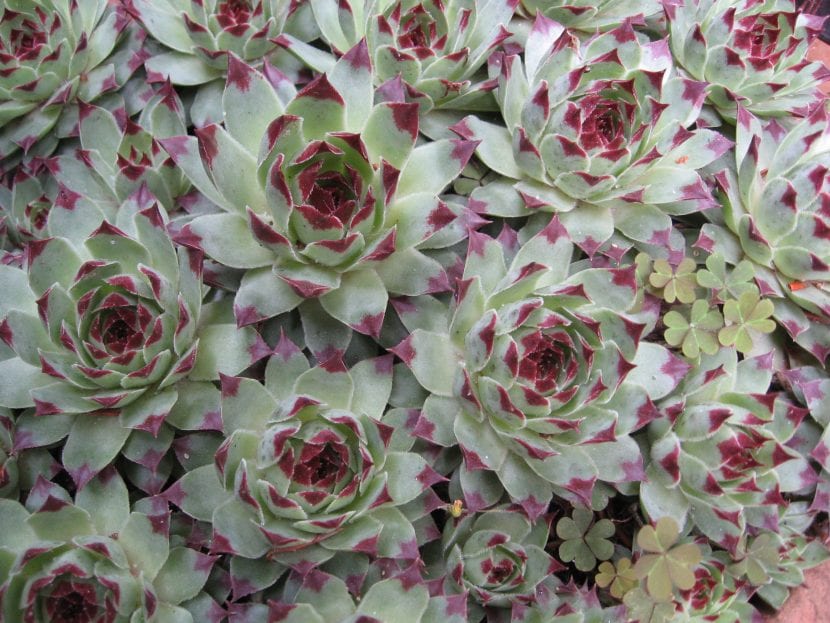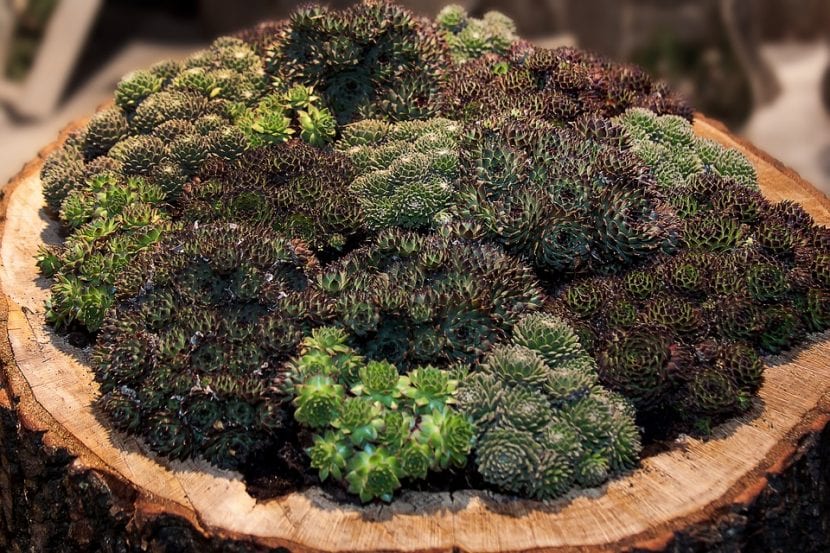
Sempervivum tectorum
All the always alive they are one of the easiest non-cacti succulent or succulent plants in the world. They resist drought, sub-zero temperatures, heat (although without reaching the extreme), and they also multiply very easily and quickly.
But do you know where they come from? If you want to get closer to their world, and learn to cultivate them better, then we are going to talk at length about them 🙂.
Origin and characteristics

Sempervivum pilioseum // Image - Wikimedia / David J. Stang
They are non-cactaceous succulent plants, or for short, succulent or simply succulent plants, belonging to the genus Sempervivum originating in Spain (mountains of the Iberian Peninsula and the Canary Islands), the Carpathians, Turkey, Armenia, and the Caucasus. They form rosettes of monocarpic leaves, that is, after flowering they die, leaving new suckers that sprout from their roots.
They grow to heights of no more than a foot; however, they can occupy a very large space, exceeding fifty centimeters if they are allowed to grow freely.
Main species
The genus is made up of around thirty species, the following being the most popular:
Sempervivum tectorum

Image - Wikimedia / Qwertzy2
It is native to the north of the Iberian Peninsula. Grows to a height of 50 centimeters by 15-30cm wide. The leaves are greenish, with purplish tips. Its pink or reddish flowers sprout from a long stem 30-50cm tall during the summer.
Sempervivum montanum

Image - Wikimedia / Guérin Nicolas
It is native to the Pyrenees, Alps, Carpathians and Corsica. Grows up to 20 centimeters tall by 20-40cm wide, forming dull green leaves. Its purple-red flowers sprout from a 15-20cm tall stem in summer.
Sempervivum arachnoideum

Image - Wikimedia / Guérin Nicolas
Known as a cobweb evergreen, it is native to the Alps and the Carpathians. Grows up to 10-15cm tall, by about 35cm wide. The leaves are green, and from each tip they seem to produce fine white "hairs" similar to the webs that spiders make. In summer its red flowers sprout from stems up to 15cm tall.
Sempervivum calcareum

Image - Wikimedia / Cillas
It is native to the Alps, and grows up to 20 centimeters tall by 30cm wide. The leaves are green, with reddish purple tips. It is very similar to S. tectorum, but this only grows in the Alps, its size is smaller and the color of the tips is more marked.
What is the care of the immortelle?

If you want to have a copy (or a few and make compositions as beautiful as the one in the image above), here are a few tips:
Location
They are plants that have to be outside, but where exactly? Well, it depends a lot on the weather:
- Temperate-cold: If you live in an area where frosts occur and where temperatures in summer are mild, you can have them in direct sun.
- Temperate-warm / warm: if you live in an area where temperatures are mild except in summer when they are high, it is best to put them in semi-shade.
Irrigation
As we said at the beginning, they are very resistant to drought, but for them to have a good development and are healthy, it is not advisable to have them without water for weeks. In fact, I can tell you that I, living in the Mediterranean with temperatures of up to 38ºC in the middle of summer, where the drought lasts for months, if I did not water them 1-2 times a week during the hottest season and every 10-15 days the rest of the year, I lose them.
And it is that the insolation here is very high, so much that it makes the substrate dry very quickly, almost overnight. For this reason, if the climate you have in your area is similar, you should also water from time to time.
Of course, if on the contrary it tends to rain regularly, space out the waterings, because watering little is as bad as watering a lot. If in doubt, check the humidity of the soil, for example by weighing the pot once it has been watered and again after a few days, or with a thin wooden stick (if it comes out with a lot of adhering soil when you remove it, do not water).
Subscriber

Image - Wikimedia / Meneerke Bloem
From early spring to late summer It is advisable to pay it with organic fertilizers, such as guano. But if you only have it as an ornamental plant, use specific fertilizers for succulents, following the instructions specified on the package.
Multiplication
The Sempervivum multiply by separation of stolons in spring-summer. To do this, all you have to do is, with scissors previously disinfected with alcohol, separate them with a little root and plant them in pots with universal growing substrate mixed with perlite in equal parts.
Then, you just have to take care of it like a normal and ordinary plant 🙂.
Rusticity
Resists cold and frost up to -18ºC, but extreme heat (over 38ºC does not suit you too well.
What uses does it have?

Ornamental
It is very decorative. As it forms rosettes of not very tall leaves, it is perfect for growing in pots as specimens of a single species, or for creating compositions.
Medicinal
Since ancient times these plants have been used for their anti-inflammatory properties, as well as treatment against infections such as otitis, tracheitis, pharyngitis or candidiasis. They also serve to remove corns and freckles by making juices with the leaves.
What do you think of these plants?